Le Tastevin - September 17, 2014 - California and Franken (Host: Bob and Ethan)
California
2003 Sonoma Cutrer Chardonnay
2002 Berginer Sbragia Chardonnay
2009 Littorai Thieriot Chardonnay
1996 Grace Vineyard 29 Cabernet Sauvignon
2008 Domaine Drouhin Laurene Pinot Noir
2008 Pelerin Rosella's Vineyard Pinot Noir
Franken
2000 Untereisenheimer Sonnenberg Bacchus - Franken Kabinett
2005 Sommeracher Katzenkopf Kerner Kabinett - Winzer Sommerach, Der Winzerkeller
2006 Sommeracher Katzenkopf Scheurebe Kabinett - Winzer Sommerach, Der Winzerkeller
2001 Schlossberg Riesling Spätlese - Castell
2001 Thüngersheimer Scharlachberg Silvaner Kabinett Trocken – Winzergenossenschaft Thüngersheim
2001 Hallburger Schlossberg Silvaner Kabinett Trocken
2000 Juliusspital Silvaner Trocken
2005 Schloss Castell Silvaner Trocken – Castell
Images of some of the sampled wines:
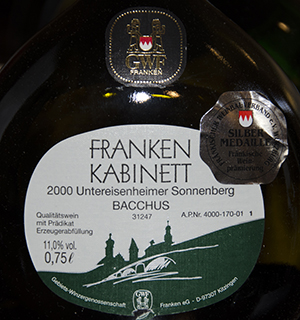
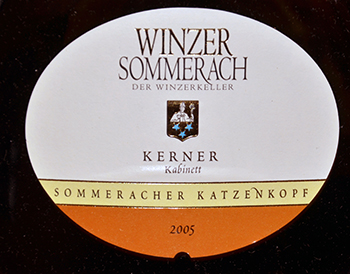
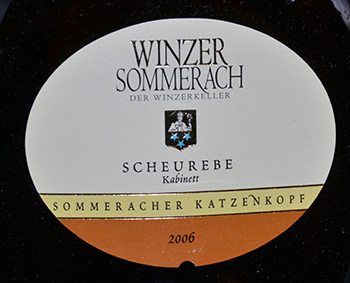
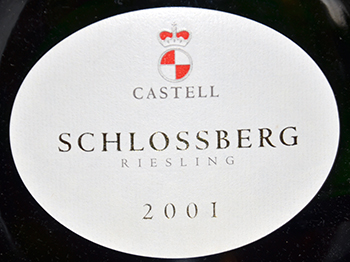
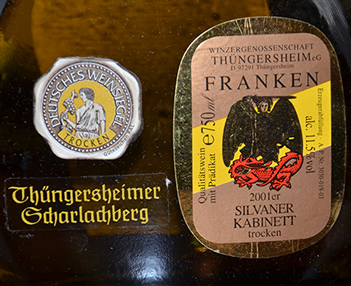
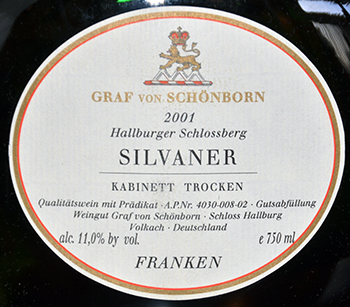

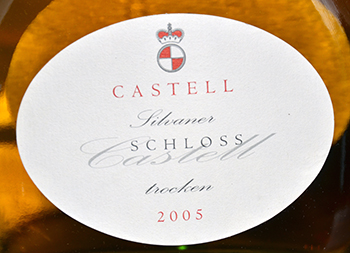
Ethan's notes on the Franken wines:
Being at the northern range for many white and red varieties, climate change is being kinder to German wine production than other regions of the world. Growing seasons are lengthening and, together with a wide variety of topography and terrains, other areas in German are becoming better known. Excellent wines are now made from regions such as Pfalz (geographic continuation of Alsace), Hessische Bergstrasse, Baden (especially Kaiserstuhl and Breisgau), and Franken (Fraconia).
Five grape varieties are presented tonight. One pure Riesling, and three others that are crosses with Riesling: Bacchus, Kerner, and Scheurebe. These crosses represent attempts to deal with earlier harsher conditions for Riesling to do well in Franken. The other variety, Silvaner, is itself a cross with Savagnin (a Traminer variety), which is grown in France’s Jura, and a white variety that has its origins in Austria.
History
The Celts who settled Fraconia certainly drank wine, but did not plant vineyards or tended to grapes as part of their agriculture. There is currently no evidence of Roman viniculture as there is in the German wine areas of Rhein and Regensburg; Roman defensive lines tended to run south of the Fraconia wine area. Probably the first vineyard was established with cloisters during the introduction of Christianity in the 4th-6th Centuries, with the first documented mention of a Franien vineyard in 766 through a gift from Charlemagne in the area of Hammelburg at the Fulda Cloister. During the Medieval Warm Period, the area of Franconia saw rapid expansion in planted vines with approximately 40,000 hectares by 1000. In 1576 the first mention of the famous “Bocksbeutel”, the unique wine identifier of Franken Wine, was made in a stone relief picture at the Juliusspital in Würzburg. The origin of the name “Bocksbeutel” is still disputed. The most probable origin is the “Bugsbeutel,” a field bottle worn on the body or carried as a “pilgrim’s bottle”. It has the shape whereby it is difficult to tip over. Other theories, less substantiated, are more entertaining. One is “Booksbüdel”, a small sack used to protect and carry books, in particular prayer books or song books carried on travels. It is derived from low German (Niederdeutsch), which wasn’t spoken in Franken (Frankisch is a middle German Dialect) and would likely not have been understandable at the time. The third, and from a marketing prospective most interesting, is from Bokesbudel, or “ram’s scrotum.”
From 1200 through 1960, the total amount of land dedicated to wine production declined. This was due to changing climate, particularly after 1600 when it became markedly colder, decimation of population through disease, civil war and international conflict, industrialization and decline of agriculture, and a series of diseases affecting most vine stock. Wine production in the first half of the 1900s was rather primitive, a family endeavor utilizing only basic means of production – wagons, manual labor, and small production sites. 15 years after WW2, the area under wine cultivate was less than 2,500 hectares.
It was only after WW2 in mid-1950s that a state-sponsored effort was made to revitalize wine production in Fraconia. Government support for land and water acquisition, new vineyard planting, and production and marketing techniques turned things around. Universities began to school specialists in enology, land and water management, mechanization and fertilization. Further work was done to encourage new crosses that boosted production in a cool climate. Essentially much had to be relearned about wine-making: identifying the best tracts, regulating irrigation, erosion prevention, protecting areas from flooding, planting disease-resistant rootstock, and application of high-producing varieties to cover costs and provide a product to market. After the 1960s the “Recovery Period” gave way to the “Modern Wine Period”. The focus shifted from quantity production towards marketing and tourism, diversification and quality, especially for wines produced from the best sites. Land acquisition and total production gave way to land care and selection, mechanization gave way to enology and environmental care. Today there are about 6200 hectares of land in wine production, with about 110 producers. 60% of all costs are still covered by the state.
Geology, Climate and the Wine Varieties
The Franken wines presented tonight are principally from an area called the “Maindreieck,” or the Main River Triangle, although the wines from Castell are east of that area. Franken is principally a white wine area, with 80% of total production being white varities – Silvaner, Müller-Thurgau, Riesling, Bacchus, Weißburgunder (Pinot Blanc, a point genetic mutation of Pinot Noir) and the Scheurebe. The main red variety grown is Spätburgunder (Pinot Noir). In climate, the area overlaps the western influences of the Atlantic, the source of most precipitation, and continental Europe, which tends to be hotter in the summer, colder in the winter. Climate change has shifted Franconia into a “North Italian” climate regime, with longer vegetation periods and milder winters. However, the danger of extreme frosts has become an issue, and can occur as late as May. Compared to the western producing regions of Mosel and the Rhein, Franken is markedly drier, with autumn conditions of warm days and very cool nights. The “reading” (Lese) of Riesling often can occur as late as November.
Soils of the region are a mixture of sandstone, limestone and some sedimentary shales and dolomites. The wines presented tonight are from better sites located on limestones, which are ideal for the dry, white descriptive wines.
Bacchus was created by viticulturist Peter Morio at the Geilweilerhof Institute for Grape Breeding in 1933. He took a Silvaner x Riesling cross and crossed that with Müller-Thurgau, which is itself a cross between Riesling and Madeleine Royale. Bacchus received varietal protection and was released for general cultivation in 1972. Its name is taken from Roman name of the Greek wine god Dionysus. Bacchus can reach high must weights and has no high requirement for sites it can be planted. It can therefore be used where e.g., Riesling does not ripen reliably. It ripens about the same time as Müller-Thurgau and shares that variety's high productivity. If allowed to fully ripen, Bacchus wines can have powerful flavors and “exuberant” character. It is, however, low in acidity, which does not always make it very well suited for varietal wines under typical German growing conditions. Therefore, Bacchus is often used for blending with Müller-Thurgau to give the latter more flavor. Bacchus is also grown in England. Under British growing conditions, where the colder climate means that a higher acidity is retained and where only lower yields are possible, Bacchus can give varietal wines of reasonable quality, somewhat in a Sauvignon blanc-like style.
Kerner is a varietal bred in 1929 by August Herold by crossing Trollinger (a red variety also known as Schiava grossa or Vernatsch) and Riesling. Kerner was named in honour of a 19th Century poet and physician from Swabia, Justinus Kerner, whose works included songs and poetry on wine. It remained mostly unknown outside the Württemberg region of Germany, but was more widely planted after the war. It received varietal protection and was released for general cultivation in 1969. In 2006 Kerner was the 8th most planted variety in Germany. The trend since the mid-1990s is that German plantations of Kerner have decreased as has other "new breeds" of white varieties, such as Müller-Thurgau and Bacchus. Kerner is also grown in Austria (Styria), Switzerland and the Italian province of South Tyrol. It was introduced into South Tyrol in the early 1970s and awarded DOC status in 1993. Kerner is not fussy about where it’s grown, and in Germany, a land dominated by the site-specific Riesling, this is a key attribute. It is high yielding, ripens reliably and, as it buds late, is protected from spring frosts. Like Riesling, Kerner is high in acid and has the ability to age well for many years.
Scheurebe, or Scheu’s Wine, is primarily grown in Germany and Austria, where it often is called Sämling 88 (Seedling 88), and some parts of the New World. Scheurebe wines are highly aromatic, and the variety is often used for sweet wines, although dry Scheurebe is common in Germany. Scheurebe was created by viticulturalist Dr. Georg Scheu in 1916, when he was working as director of a grape-breeding institute, by crossing Riesling with an unknown wild vine. His purpose was to create a superior version of Silvaner, with more aroma and greater resistance to frost damage and chlorosis. It was long assumed that Scheurebe was Silvaner x Riesling, but DNA analysis in the late 1990s ruled out Silvaner as a parent, while confirming Riesling a lineage. It is known that Scheu was working on wild vines, so it is likely a misidentification of the cross took place. Seedling (in German Sämling) number 88 was simply Scheu's serial number for the vine plant selected for its properties. It was named in Scheu's honour in 1945. The Rebe suffix is simply the German word for vine. Scheurebe received varietal protection and was released for general cultivation in Germany in 1956, after Scheu's death.
Riesling, which you’re all familiar with, originated in the Rhine region of Germany. The better wines produce a flowery, almost perfumed aromas as well as high acidity. Notable is the many wines of incredible and world-class taste, longevity and character with low alcohol content. In terms of importance for quality wines, it is usually included in the "top three" white wine varieties together with Chardonnay and Sauvignon Blanc. Riesling is highly "terroir-expressive", and is clearly influenced by the wine's place of origin and extant growing conditions and weather.
Silvaner is the variety most identified with Franken. Unfortunately, it is best known as a component of crappy Liebfraumilch and whose production boomed in the 1970s. Fortunately, Silvaner’s reputation remained strong in Franken. Silvaner is an ancient variety long grown in Central Europe. DNA fingerprinting suggests it to be a cross between Traminer and the "hunnic" variety Österreichisch-Weiß (meaning "Austrian White"). It is now thought to have originated in Transylvania, arriving in Franken after the Thirty Years War (there is a record of Silvaner from Austria being planted at County of Castell in Franconia on 5 April 1659). Before Much Silvaner was planted in Germany and Alsace after the Second World War, reaching 30% and 25% respectively of total vineyard area in the 1960s - 1970s. It was Germany's most grown variety until it was overtaken by Müller-Thurgau around 1970. Much of the German crop was blended into Liebfraumilch, but overproduction ruined its reputation, and changing tastes led to many vines being grubbed up. However, in Franken, where Liebfraumilch may not be produced and which primarily stuck to dry white wines, Silvaner kept its popularity. Although Silvaner has been planted elsewhere, it is in Franken where it thrives. A Silvaner wine from Franconia is typically sold in the Bocksbeutel. Silvaner in Franken does best on the chalky Muschelkalk terroir, where it can compete with the best German white wines from Riesling grape. These powerful wines are considered food-friendly and are often described as having an "earthy" palate. Under Erste Lage/Grosses Gewächs rules, Silvaner may be used for Grosses Gewächs wines (top-end dry wines), but only in Franconia and Saale-Unstrut and not in any of the other 11 German wine regions. Silvaner is also grown in Rheinhessen and Palatinate, and is sometimes also made into dessert wine. The Silvaner is usually not matured in barrique barrels. This because the fine and fruity body of the Silvaner would be overwhelmed by the oak taste.
Page last edited: January 14, 2015 (EB)
©2015 Le Tastevin wine club
